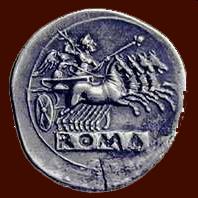









Looking After Your Finds - Finds




Roman - Identification Earrings - Jewellery


Powered By Sispro1

Copyright All Rights Reserved by Nigel G Wilcox E-Mail: ngwilcox100@gmail.com
Unearths rare find
Metal detecting on land owned by James Wildon in Handsacre.
TWO "bits of metal" found by a Tamworth man have officially been declared as treasure.
Belgrave resident Graham Hogg found two incomplete clothes fasteners on June 22, 2014. He had in fact unearthed two precious metal dress hooks dating back to between the 16th and 17th Centuries.
A treasure inquest in to the items was held at Cannock Coroner's Court on Tuesday (July 21), during which the court heard from Teresa Gilmore, the finds liaison officers for Staffordshire and the West Midlands, from the Birmingham Museums Trust and Portable Antiquities Scheme.
the front of both hooks were 39.5 percent and 34.6 percent gold, and 42.4 percent and 49 percent silver.back of the hooks were 86 and 82 percent silver respectively and definitely over 300 years old
Metal detecting on land owned by James Wildon in Handsacre.
TWO "bits of metal" found by a Tamworth man have officially been declared as treasure.
Belgrave resident Graham Hogg found two incomplete clothes fasteners on June 22, 2014. He had in fact unearthed two precious metal dress hooks dating back to between the 16th and 17th Centuries.
A treasure inquest in to the items was held at Cannock Coroner's Court on Tuesday (July 21), during which the court heard from Teresa Gilmore, the finds liaison officers for Staffordshire and the West Midlands, from the Birmingham Museums Trust and Portable Antiquities Scheme.
the front of both hooks were 39.5 percent and 34.6 percent gold, and 42.4 percent and 49 percent silver.back of the hooks were 86 and 82 percent silver respectively and definitely over 300 years old
dates to between AD 1200 to 1400
two stirrup rings
Designed by Nigel G Wilcox
Complimentary Topics
The Paragon Of Metal Detecting
& Archaeology
& Archaeology
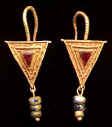
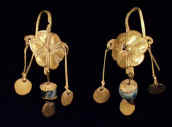
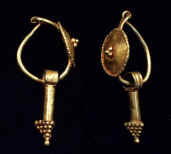
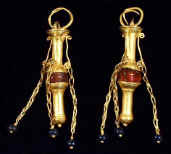
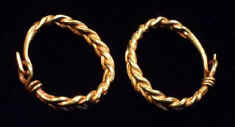

ROMAN GOLD EARRINGS II-III c. A.D.
Solid round wire hoop with freely moving pendant and hoop and hook fastener. Round, slightly convex shield edged with beaded wire and granulated pyramid in the center. The pendant consists of a ribbed suspension loop, long hollow cylinder with horizontal fluting and granulated pyramid. 35 mm.
Solid round wire hoop with freely moving pendant and hoop and hook fastener. Round, slightly convex shield edged with beaded wire and granulated pyramid in the center. The pendant consists of a ribbed suspension loop, long hollow cylinder with horizontal fluting and granulated pyramid. 35 mm.
SARMATIAN GOLD AND CARNELIAN EARRINGS I - first half of II c. A.D.
Carnelian bead with vertical hole enclosed within two truncated cones with wound wire bands. They are soldered to cylinders, one of which is joined to the truncated cone at the opposite end; another one joined to a bi-conical hollow bead. At the top cylinder there are three long, wire volutes with free moving loop-in-loop chains terminated by blue glass beads. The gold wire axle pin goes through all of the parts, starting at the bottom of the bi-conical bead and at the top penetrates the cap, coils around the suspension loop where the free ended ear wire goes through. 46 mm.
Carnelian bead with vertical hole enclosed within two truncated cones with wound wire bands. They are soldered to cylinders, one of which is joined to the truncated cone at the opposite end; another one joined to a bi-conical hollow bead. At the top cylinder there are three long, wire volutes with free moving loop-in-loop chains terminated by blue glass beads. The gold wire axle pin goes through all of the parts, starting at the bottom of the bi-conical bead and at the top penetrates the cap, coils around the suspension loop where the free ended ear wire goes through. 46 mm.
ROMAN GOLD EARRINGS II-III c. A.D.
Hoop consists of two thick wires, twisted in opposite directions forming a “braid”. Their ends have been hammered together to form single, round cross section wires, tapering at both ends: one is forming a loop with spirally twisted end in two coils, the other one forming a hook. L. 22 mm.
Hoop consists of two thick wires, twisted in opposite directions forming a “braid”. Their ends have been hammered together to form single, round cross section wires, tapering at both ends: one is forming a loop with spirally twisted end in two coils, the other one forming a hook. L. 22 mm.
3 Roman earrings II-III c. A.D.
Gold solid tapered wire with a cluster of 4 granules on the bottom.
L. up to 22 mm.
Gold solid tapered wire with a cluster of 4 granules on the bottom.
L. up to 22 mm.
ROMAN GOLD EARRINGS III c. A.D.
S-shaped hoop with bent tip; The other end of the hoop flattened and perforated, protrudes below the six-petals rosette shield. Horizontal flat bar with projecting and perforated ends soldered to the back of the shield and under the hoop. The side pendants made of rectangular cross-section wire with suspended discs. The central pendant made of rectangular cross-section wire with suspended disc and blue glass bead enclosed in caps, decorated with dots and lines in relief. 38 mm. Estimated value: 638.06
S-shaped hoop with bent tip; The other end of the hoop flattened and perforated, protrudes below the six-petals rosette shield. Horizontal flat bar with projecting and perforated ends soldered to the back of the shield and under the hoop. The side pendants made of rectangular cross-section wire with suspended discs. The central pendant made of rectangular cross-section wire with suspended disc and blue glass bead enclosed in caps, decorated with dots and lines in relief. 38 mm. Estimated value: 638.06
ROMAN GOLD EARRINGS II-III c. A.D.
Beaded, hooked ear wire soldered to a triangle shield with beaded wire frame. Additional beaded wire and granulation around a triangular garnet bezel-set in the center. Solid wire with three blue glass beads suspended from the bottom corner of the shield. L. 41 mm.
Beaded, hooked ear wire soldered to a triangle shield with beaded wire frame. Additional beaded wire and granulation around a triangular garnet bezel-set in the center. Solid wire with three blue glass beads suspended from the bottom corner of the shield. L. 41 mm.
1.
2.
3.
4.
5.
6.
Pages
B=Bracelets
ER=Ear-Rings
P=Pendants
T=Template
ER=Ear-Rings
P=Pendants
T=Template
Rings
[1]
[2]
[3]
[4]
B ER P T
[5]
[7]
[8]
Main Coin Menu
Roman Coins
Menu
Menu
Member NCMD
Roman Menu























